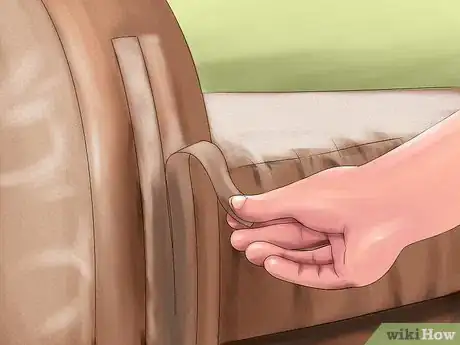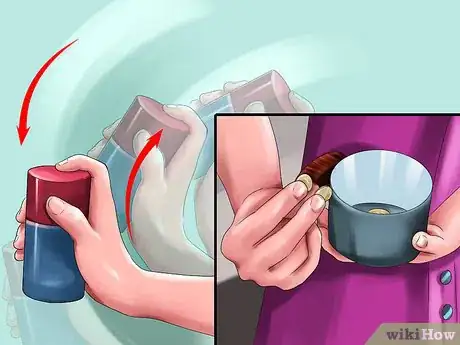This article was co-authored by Lauren Baker, DVM, PhD and by wikiHow staff writer, Jessica Gibson. Dr. Lauren Baker is a Veterinarian and Assistant Scientist at the University of Wisconsin-Madison. With over 10 years in veterinary medicine, she specializes in the concept of “one health,” which uses insights from veterinary medicine to help human medical research. She holds a Ph.D. in Comparative Biomedical Sciences, a Doctor of Veterinary Medicine, an MS in Comparative Biomedical Sciences, and a Bachelor’s degree in Psychology from the University of Wisconsin-Madison.
This article has been viewed 102,585 times.
Cats scratch to stretch muscles, remove old claw sheaths, and communicate with one another. To a cat, furniture may seem like a natural place to scratch. Instead of declawing your cat, there are a few things you can do to protect the furniture while you also train your cat. Teach your cat not to scratch the furniture by offering scratching posts, rewarding good behavior, and being consistent with training. Your cat will soon prefer its scratching post and rewards over scratching the furniture.
Steps
Caring For Your Furniture
-
1Use furniture covers. If you're mainly concerned that your furniture will become dirty or hairy from your cat, cover it with slipcovers. You can purchase a slipcover for couches, chairs, or recliners in a variety of colors and fabrics. Choose a fabric that you can easily wipe clean or toss in the washing machine.[1]
- If you don't want to always keep a cover on the furniture, you can lay down a towel where your cat usually likes to rest. Just remove the towel and wash it every day or two.
-
2Spray a scent deterrent on the furniture. Buy a repellent spray that your cat doesn't like and spray it on the furniture that your cat usually scratches. You can purchase deterrent sprays at most pet stores. Follow the manufacturer's instructions to spray your furniture.[2]
- You may need to reapply the scent deterrent once it begins to wear off.
Advertisement -
3Lay double-sided tape on the furniture. Spread double-sided tape on places where your cat prefers to scratch. Your cat won't like the sticky feeling so should eventually stop scratching there. Most commercial double-sided tapes shouldn't leave a sticky residue on your furniture.[3]
- If you'd rather startle your cat than apply sticky tape, tape a few balloons in places where your cat usually scratches. When your cat goes to scratch, it will pop a balloon. The surprise may stop your cat from scratching.
-
4Trim your cat's claws. Keep your cat's claws clipped close (but not too close) so its nails are dull and won't do as much damage if it scratches the furniture. If your cat resists clipping, try wrapping it in a towel while you trim or get the nails professionally trimmed.
Training Your Cat
-
1Offer your cat a scratching area. If your cat likes to claw, place a sisal scratching post next to the place it usually scratches. Your cat might prefer this rough, natural fiber as long as the post is solid and won't tip over. If your cat likes to scratch wooden legs of your furniture, use a cedar scratching post. Or if your cat prefers to scratch the soft upholstery of furniture, set out a carpeted scratching post.[4]
- Be sure to place your cat's scratching furniture in an area where they like to scratch. If, for example, they like scratching on your sofa in the living room, put a scratching post in the living room.
-
2Encourage your cat to use the scratching area. Rub a little catnip on the scratching posts to attract your cat to them. You might need to occasionally add more catnip to keep your cat interested. You may want to set up more than one post or scratching space in your house, especially if your cat likes to scratch several pieces of furniture.
- Try to place them in a variety of places so your cat can choose when and where to scratch.
- Take note of the type of scratching your cat likes to do. If, for example, they like to get on their hind legs and scratch up high, they probably won't use a low-laying scratching pad. Instead, opt for a taller scratching post.
-
3Reward your cat for good behavior. As soon as you notice your cat using the scratching post instead of the furniture, reinforce the good behavior. Give your cat verbal praise or put a treat at the base of the post. Or you could give your cat a few belly rubs.[5]
- For example, when you see your cat scratching the post say, "Good cat!" in a friendly tone and rub it behind its ears or give it a treat.
-
4Say "no" and be consistent with training. If you see your cat scratching the furniture instead of the post, make a loud noise (like clapping) to startle them. Remove them from the furniture and firmly say "no." Do this every time you see your cat scratching the furniture.[6]
- Don't yell or get angry at your cat. Remember that cats need to scratch in order to keep their nails trimmed. It's also a way that they communicate with other cats.
-
5Startle your cat if you see undesirable behaviors. Some cats may keep scratching furniture even if you tell them no and remove them. Try startling your cat every time you see it misbehaving. For example, if your cat jumps up onto a couch where you don't want it, walk towards your cat while shaking a can that contains a few pennies.[7]
- Keep in mind that this typically only stops your cat from scratching when you are around. You will need to combine this with other deterrents for bad behavior and rewards for good behavior to ensure overall success.
-
6Keep your cat active. Cats are more likely to scratch on furniture if they're bored or need attention. Spend time playing with your cat. Staying active and entertained can reduce misbehavior. For example, you could dangle ribbons on a stick, toss small balls or toys to your cat, or hide treats in puzzle balls for it to find.[8]
- Consider setting up a play area for your cat that includes items it can scratch. For example, buy an indoor play tree that has a scratching post. Place this near your cat's favorite furniture or by a window so it can look outside.
Expert Q&A
-
QuestionWhat are some tricks to stop my cat from scratching my furniture?
 Brian Bourquin, DVMBrian Bourquin, better known as “Dr. B” to his clients, is a Veterinarian and the Owner of Boston Veterinary Clinic, a pet health care and veterinary clinic with three locations, South End/Bay Village, the Seaport, and Brookline, Massachusetts. Boston Veterinary Clinic specializes in primary veterinary care, including wellness and preventative care, sick and emergency care, soft-tissue surgery, dentistry. The clinic also provides specialty services in behavior, nutrition, and alternative pain management therapies using acupuncture, and therapeutic laser treatments. Boston Veterinary Clinic is an AAHA (American Animal Hospital Association) accredited hospital and Boston’s first Fear Free Certified Clinic. Brian has over 19 years of veterinary experience and earned his Doctor of Veterinary Medicine from Cornell University.
Brian Bourquin, DVMBrian Bourquin, better known as “Dr. B” to his clients, is a Veterinarian and the Owner of Boston Veterinary Clinic, a pet health care and veterinary clinic with three locations, South End/Bay Village, the Seaport, and Brookline, Massachusetts. Boston Veterinary Clinic specializes in primary veterinary care, including wellness and preventative care, sick and emergency care, soft-tissue surgery, dentistry. The clinic also provides specialty services in behavior, nutrition, and alternative pain management therapies using acupuncture, and therapeutic laser treatments. Boston Veterinary Clinic is an AAHA (American Animal Hospital Association) accredited hospital and Boston’s first Fear Free Certified Clinic. Brian has over 19 years of veterinary experience and earned his Doctor of Veterinary Medicine from Cornell University.
Veterinarian
References
- ↑ https://www.petcha.com/7-easy-ways-to-protect-your-furniture-from-your-pets/
- ↑ http://petslady.com/article/3-easy-ways-protect-your-furniture-cat-scratching
- ↑ http://petslady.com/article/3-easy-ways-protect-your-furniture-cat-scratching
- ↑ http://www.drsfostersmith.com/pic/article.cfm?articleid=666
- ↑ http://www.perfectpaws.com/scratch.html#.WT9VDGjyvIU
- ↑ http://www.humanesociety.org/animals/cats/tips/destructive_scratching.html
- ↑ http://www.humanesociety.org/animals/cats/tips/destructive_scratching.html
- ↑ http://www.cats.org.uk/uploads/documents/cat-care-leaflets-2013/EG10_Managing_your_cat's_behaviour.pdf
About This Article
To protect furniture from cats, use furniture covers made of washable fabrics to prevent stains and fur buildup. If you're concerned about your kitty scratching the furniture, spray it with a scent deterrent and remember to keep the cat's claws trimmed. It can also help to provide a scratching post to encourage your cat to scratch it instead of the furniture. If you catch your kitty in the act, say "No!" in a firm voice and clap your hands to startle it. Do this every time to train the cat to stop the undesirable behavior. For tips on training your cat with rewards, read on!






































































